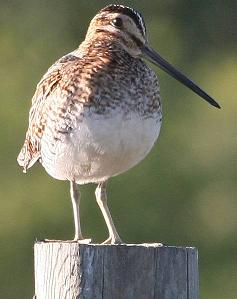Wilson's Snipe

Some people probably remember belonging to a
group such as the boy scouts that went snipe hunting on a
camping trip. Many of them came away with the belief
that snipes don't actually exist. They do exist they,
just can't be caught by hand.
Identification and Pictures
(Gallinago delicata)
Snipes are a stocky shorebird with
pointed-wings. Their greenish legs are short compared to
some other shorebirds. Sometimes mistaken for Spotted
Sandpipers, snipes are larger, about 10 1/2 inches.
It has an extremely long, slender pointed bill, useful for
probing in wet mud for food. It is brown with a buff
striped back, pale breast with darker spots, and bars, and the
head has alternating dark, and pale stripes. When it is
flushed a short orange tail can be seen as it flies off.
Photos by Keith Lee.
The camera I use is the Canon
EOS 40D. Visit All-birds store
The sexes are similar and the juveniles
resemble the adults.

They are easily concealed in ground vegetation
because of their camouflaged plumage. When flushed
they fly off in a series of aerial zig-zags to confuse
predators.
Wilson's snipe was formerly considered a sub
species of the Common snipe. Common snipes have eight
pairs of tail feathers, instead of seven, and a narrower white
edge to the wings.
Two other similar birds are dowitchers, which
have longer legs, lack the stripes on the back, and down the
crown, and have a white rump, and woodcocks which are
orange-buff below.
Snipe sound
Sounds they make are a chipa chipa chipa, a flight call
that is a dry, harsh rasping "kesh", and a hollow
winnowing huhuhuhu sound.
Preferred Habitat
In summer they range from Alaska through
Canada to north-central U.S., and extend from there south
through the rest of North America in the winter. In the
pacific north western U.S. snipes are residents all year long.
They like the edges of shallow ponds, marshes, bogs, stream
sides, wet meadows, and damp forests.
Breeding and Nesting
Males start arriving in the breeding territory
10 to 14 days before the females. They may be seen
singing from the top of fence posts. During
courtship flights males do an aerial territorial display where
they do a series of shallow dives in a large circle, each time
climbing back up to do it again. As they descend the
tail feathers make a strange winnowing sound. Females
build a cup-shaped nest of fine grasses, dead leaves, and
mosses lined with fine grass in a hollow ground depression, in
a wet meadow or marsh. The female usually lays 4 olive
brown eggs marked with dark spots. She will incubate
them for 18-20 days. Young birds fledge in 19-20 days.
Often the parents will split the young birds, each being
responsible for one or two. The young birds will start
to probe for their own food in around 6 days, but the parents
will still provide them with food for a while.
Food
Snipes feed on wet ground for grubs, aquatic
insects, worms, and plant material. Feeding in shallow
water they probe into the mud with their long slender bills in
a rapid sewing machine motion.
To
learn about other favorite birds click here.

|
